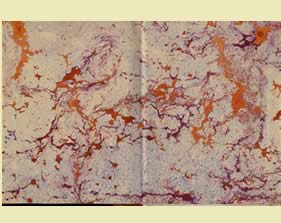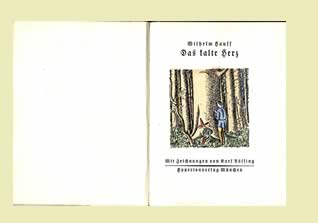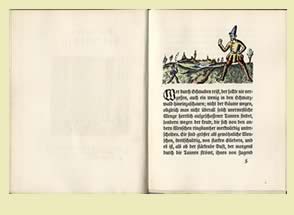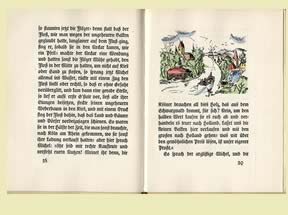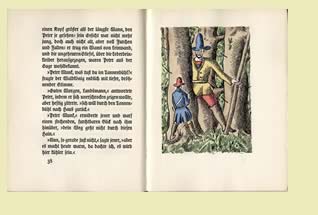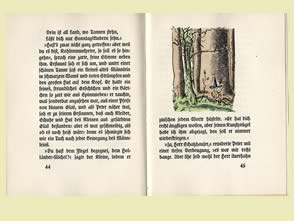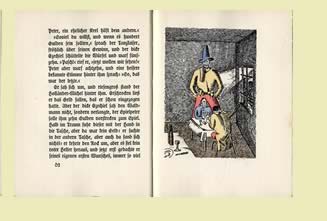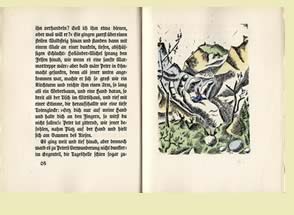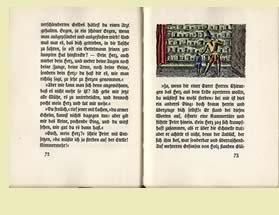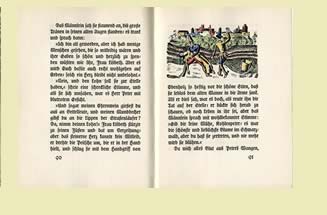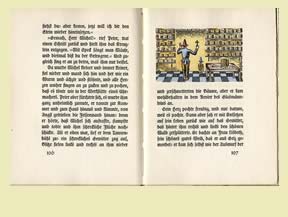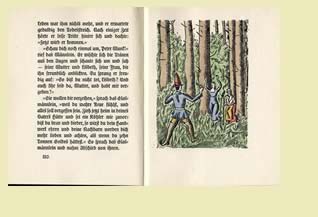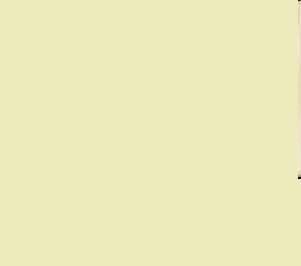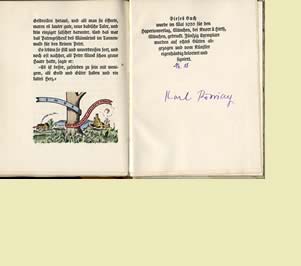Page size, 11 x 16cms.
I wanted to show as much as
I could of this beautiful little work from my collection because so
little appears to be known about the graphic work of Rossing who nevertheless
had a long and distinguished career as an artist and educator.
He was born in 1897
in Gmunden in Austria and aged 16 went to the Kunstgewerbeschule in
Munich. He was active as a printmaker in this period, producing wood
and lino cuts which drew him to the attention of the Hyperion Press (Knorr
and Wirth) publishers of this edition of Hauff's folk tale, The Cold
Heart. In 1922 he was to become a teacher at the Folkwang School in Essen
until 1931, and from 1934-1944 at the Staatliche Hochschule fur Kiumst
erziehung in Berlin-Schoneberg and from 1947 at the Akademe der Bilden
Kunst in Stuttgart (see exhibition catalogue, Prints and Drawings of
the Weimar Republic, 1987).
My copy is signed and numbered. Wilhelm Hauff (1802 -
1827) began to publish a series of fairy tales from 1826 , later collated
into Fairy Tale Almanacs.
There is an English version of the text available at 
The charcoal burner Peter Munk is presented with a series
of Folk Lore offers, three wishes, tons of cash, wordly success. Two
characters appear p- the Glass Man (little) and Dutch Michael
(giant). Both of the presences have their sinister side and clearly manipulate
him - particularly in his desires to advance his career beyond charcoal,
to get cash and prestige.
But Dutch Michael (row B no 3) offers cash and success
if you agree to surrender your own soft beating heart and have a cold
stone heart replacement. Peter goes for the transplant and sees his Mother
ejected from the family cottage without a tear. He curls his lips at
beggars and hoards his loot. Material benefits in his case are always
accompanied by the appearence of flaws in his own character idleness,
stupidity and general incompetence.
Rossing enjoys the depiction of the landscape, the huge
trees and density of the Black Forest. Tiny figures lurk in the crevices,
giants step out from behind trunks. It is a scary tale. At one stage
Peter finds his own sweet wife, Elizabeth, giving a glass of wine to
a beggar and kills her with a blow to her brow with the handle of his
whip.
Rossing makes great play of Dutch Michael's Heart Room,
where jars of hearts are ranged up on the walls (row C 2) . Peter reclaims
his own heart with a ruse suggested by the little Glass Man who gives
him a Glass Cross for the confrontation (row D 2) and Peter granted a
redemption that results in the return of his Wife and Mother (row C 3).
Rossing has shown the metamorphosis of the Glass Man
into a violent violent thug with eyes "like soup-plates" who calls Peter
a worm. "The wood spirit seized him roughly by the throat and threw him
on the ground. with such force that all Peter's bones cracked."
As is usual in the genre the tale ends with an urging
to be happy with your lot in life even if you have little in the way
of cash and belongings. In this way it is perhaps a reflection of an
anti-capitalist agrarianism that might have caught the artist's attention.
|





